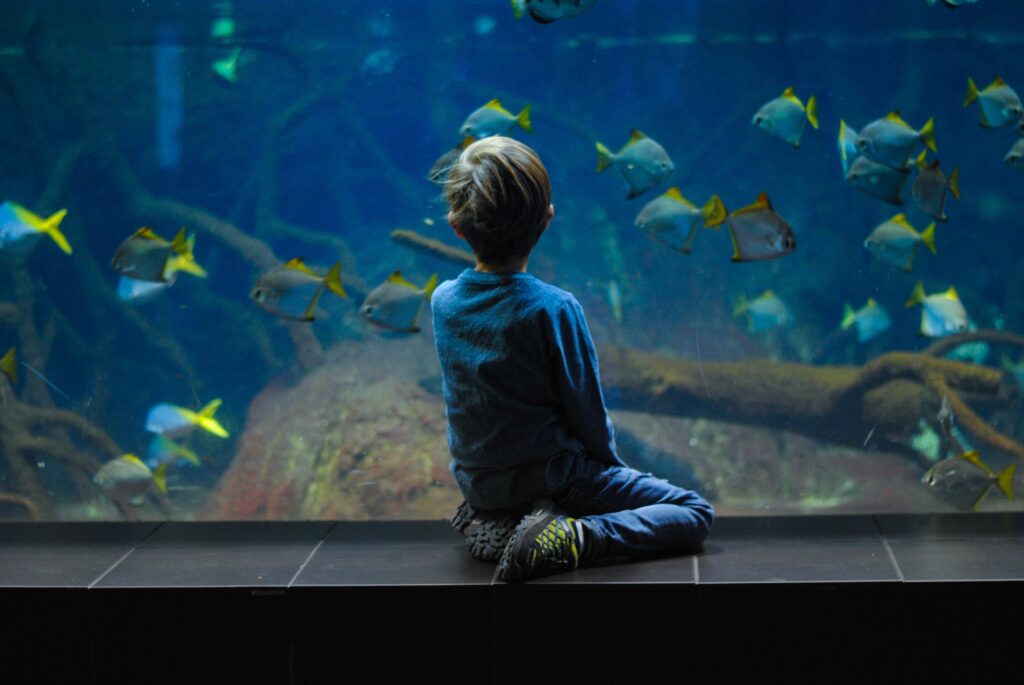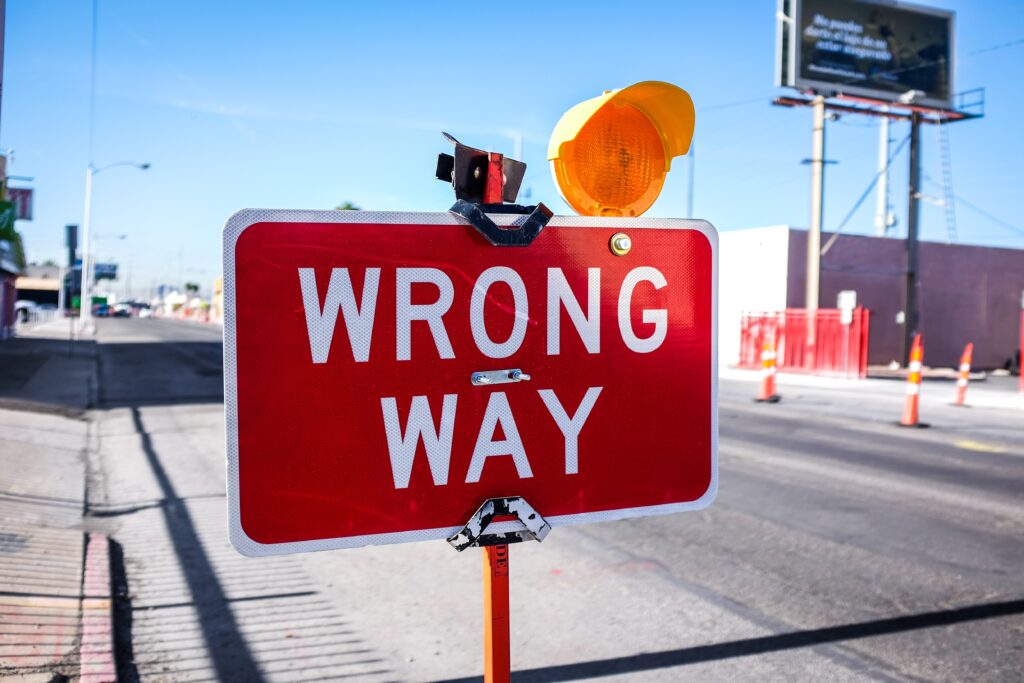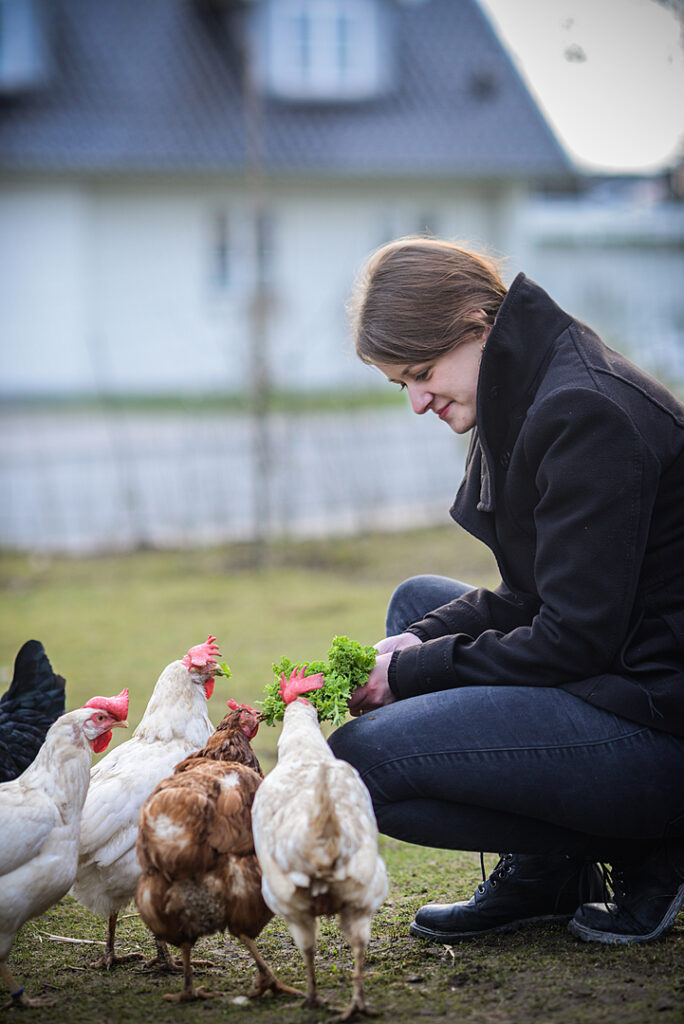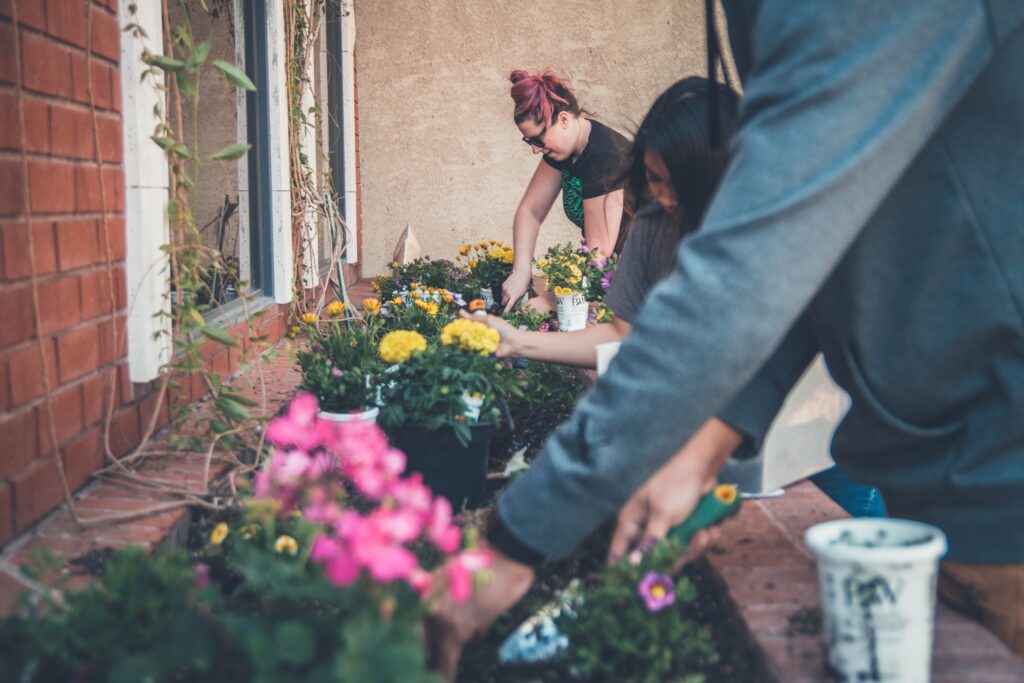
Introduction
Much of human thinking, feeling, and behavior is guided by our biases. For this reason, understanding biases that can negatively impact farmed animalsA species or specific breed of animal that is raised by humans for the use of their bodies or what comes from their bodies. is an important undertaking for animal sanctuaries. As communities that challenge the dominant treatment and sociocultural narrative of farmed animals on a daily basis, sanctuaries can utilize their unique learning space(s) alongside a deeper understanding of bias to help folks (re)imagine more compassionate ways of understanding and being in relationship with farmed animals. In this resource, we explore what biases are, how they develop and manifest, as well as several tips and tools to help folks who visit sanctuary spaces avoid and overcome the ones that can negatively impact farmed animals.
The ABCs of Bias
If we want to help folks overcome biases that can negatively impact farmed animals, it’s important that we understand what biases actually are first. In general, bias can be thought of as a particular tendency, inclination, feeling, or opinion about a person, group, thing, idea, or belief that is not founded by known facts. Although biases can sometimes be neutral or positive, they are predominantly negative and based on stereotypes that often result in discriminatory practices and harmful actions. For this reason, some social psychologists have expanded upon the more commonplace definition of bias to include three components that are referred to as the ABCs of bias:
“A” is for “Affect”
The affective component of bias consists of the prejudice or negative feelings toward a person that are based on their group membership.
“B” is for “Behavior”
The behavioral component of bias consists of the discriminatory actions taken against a person based on their group membership.
“C” is for “Cognition”
The cognitive component of bias consists of the stereotypes or generalizations about a particular group of individuals.
How Biases Develop

Biases – we all got ‘em. But where do they actually come from and how do they develop? It may come as no surprise that socialization and learning play a major role in the development of biases, particularly when it comes to biases that can negatively impact farmed animals. Although they can develop at any time during an individual’s life and vary based on culture, most biases that can negatively impact farmed animals are learned early and often. From a very young age, humans are exposed to an array of images and messages about farmed animals that drastically shape the way we understand and relate to them. Unfortunately, many of those images and messages are inaccurate and demoralizing, but very powerful nonetheless. Over time, with repetitive exposure in familial, social, and educational settings, they are absorbed into our conscious and subconscious thought processes where they often grow and crystallize into unreasoned beliefs and harmful biases that can directly impact the lived realities of farmed animals and our behaviors toward them.
Interestingly, human perceptions of animals and our decisions that impact them can also depend on more than just sociocultural factors. They can also depend on innate factors! For example, unconscious biases that have the potential to negatively impact farmed animals can be caused by biological factors such as flawed memory, the brain’s attempt to simplify information and make quick decisions, issues with paying attention, emotional input, and aging! Research also suggests that many of our gut feelings regarding certain animal species are the result of an evolutionary process that aimed to help our ancestors make decisions and judgments for survival-related purposes (e.g., mental shortcuts or heuristics). Despite knowing today that many of these innate factors can clearly influence our decision-making processes in harmful and objectionable ways, it’s important for sanctuary educators to be aware that biological factors can also play a major role in how folks perceive farmed animals. For example, it is believed that certain unappreciated species-specific behaviors and even physical attributes of animals can inadvertently arouse emotions in folks that, for sociocultural and/or innate reasons, associate those behaviors and attributes with ill-perceived characteristics and traits. Without careful guidance and a deeper understanding of what folks are witnessing when they see farmed animals, it’s not hard to imagine how misconceptions about them might be formed. The good news is, the way we perceive, relate to, and interact with animals progresses over time as our individual behaviors, communities, and scientific knowledge evolve. As sanctuary educators, our job is to make sure we help folks progress in a direction that benefits the lives of farmed animals, not disadvantages them further.
Conscious vs. Unconscious Bias


Conscious Bias
Conscious bias is a particular unfounded tendency, inclination, feeling, or opinion about a person, group, thing, idea or belief folks develop and hold that they are aware of. Individuals with conscious bias are explicit about their unfounded beliefs and attitudes, and act accordingly with clear intent. There are MANY conscious biases that people hold against farmed animals. One commonly held conscious bias is that pigs are dirty despite actually being exceptionally clean animals. Another commonly held conscious bias is that chickens are unintelligent despite being very socially and cognitively complex animals. Unfortunately, both of these unfounded beliefs have real consequences for the animals in question since being “dirty” and “unintelligent” are often considered negative characteristics by humans. Social scientists have found that humans’ emotions and behavior toward nonhuman animals are affected by our perception of certain attributes such as their competence, cuteness, warmth, familiarity, and ability to feel. Sadly, animals who are perceived as less competent, less cute, less warm, less familiar, and less able to feel tend to be treated with less moral concern.
Unconscious Bias
Unconscious bias is a particular unfounded tendency, inclination, feeling, or opinion about a person, group, thing, idea or belief folks develop and hold that they are unaware of. Interestingly, in many cases, unconscious biases are in direct contrast to the conscious beliefs and values people think they hold. Nonetheless, they can drastically influence and cloud the way folks think, feel, and behave toward others without them even realizing it. There are hundreds of different types of unconscious bias. Although many of them evolved for good reason (recall our ancestors’ need to simplify information and make quick decisions and judgments based on survival), we recognize now that they can also limit our ability to rationally respond to very important issues and make complicated decisions, including those that directly impact farmed animals. Being able to spot and identify some of the most common unconscious biases is a helpful skill to utilize in a sanctuary setting, particularly when we have to navigate tricky conversations and questions with visitors and respond to unreasoned arguments regarding farmed animals. Here are some particularly important unconscious biases you’re likely to encounter with sanctuary visitors:
Speciesism
SpeciesismA form of discrimination based on species membership; the belief that different species of animals deserve different ethical considerations regardless of whether they have similar needs or interests. is a form of unconscious bias that consists of negative beliefs, emotions, and behavior toward others based on their membership of a certain species group. Speciesism results in the belief that some animals are less morally important than humans, and that some species of nonhuman animals are less morally important than other nonhuman animals. It also often results in the inability to feel empathy for certain animal species, as well as the ability to commit harmful acts against these species that we would never commit against humans or other species of animals. For example, one might not give any consideration to the harms that may come to cowsWhile "cows" can be defined to refer exclusively to female cattle, at The Open Sanctuary Project we refer to domesticated cattle of all ages and sexes as "cows." as a consequence of our attitudes and behavior toward them, but still take such harms toward dogs into consideration. Other common forms of speciesism are the harmful attitudes and actions humans often take against other farmed animals, non-mammalian species (e.g., birds and fishes), and small animals (e.g., mice and rats).
In-group Bias
In-group bias is the tendency to give preferential treatment to others who belong to the same group they do. In many ways, in-group construction is a very natural human tendency and in some ways, a very important one, since being a part of an in-group is important for things like self esteem, identity, community, and safety. However, similar to speciesism (perhaps even an influential pre-cursor to the concept of speciesism), in-group bias often leads to the creation of a hierarchy of worth – the elevation of one group (the “in-group”) and a systematic belittling of and harmThe infliction of mental, emotional, and/or physical pain, suffering, or loss. Harm can occur intentionally or unintentionally and directly or indirectly. Someone can intentionally cause direct harm (e.g., punitively cutting a sheep's skin while shearing them) or unintentionally cause direct harm (e.g., your hand slips while shearing a sheep, causing an accidental wound on their skin). Likewise, someone can intentionally cause indirect harm (e.g., selling socks made from a sanctuary resident's wool and encouraging folks who purchase them to buy more products made from the wool of farmed sheep) or unintentionally cause indirect harm (e.g., selling socks made from a sanctuary resident's wool, which inadvertently perpetuates the idea that it is ok to commodify sheep for their wool). against other groups (the “out-groups”), particularly when some groups are more powerful or vulnerable than others.
Hyperbolic Discounting
Hyperbolic discounting is the tendency to prioritize the present over the future. Although this bias evolved for good reason (e.g., to help our ancestors focus on what might kill us now vs. later!), it can now limit our ability to take action and address complex issues that we may not feel the direct impact from until a bit further into the future. For example, while many humans may understand what needs to be done to address the issues facing and related to farmed animals (e.g., animal exploitationExploitation is characterized by the abuse of a position of physical, psychological, emotional, social, or economic vulnerability to obtain agreement from someone (e.g., humans and nonhuman animals) or something (e.g, land and water) that is unable to reasonably refuse an offer or demand. It is also characterized by excessive self gain at the expense of something or someone else’s labor, well-being, and/or existence., climate change, food justice, etc.), it’s hard for a lot of folks to see how the changes and sacrifices required for generations far off into the future are worth considering right now.
The Bystander Effect
The bystander effect is the tendency for a person to assume (often wrongly) that someone else must be doing something or will do something to help a victim, deal with a crisis, or solve a complex issue. This bias occurs in group settings, and the larger the group, the stronger the bias becomes.
The Sunk-Cost Fallacy
The sunk-cost fallacy is the tendency to stick with endeavors or decisions in which we’ve already invested time, money, energy, and other resources, even when changing our decision would be more rational and more beneficial. In other words, folks often make irrational decisions because they have a tendency to factor in influences other than the current alternatives. This helps explain, for example, why so many humans continue to rely on animal productsAnything that originates from an animal’s body, including things like their eggs, feathers, flesh, honey, milk, and wool. as a primary source of nutrition even in the face of strong evidence that most humans can and should transition to a diet that is much less reliant on animal products if available to them.
Confirmation Bias
Confirmation bias is the tendency to favor information that reinforces our existing assumptions and beliefs, and to ignore or discount any information that may support an alternative viewpoint.
Attentional Bias
Attentional bias is the tendency to pay attention to some things while simultaneously ignoring other things. Although this can help us focus on pieces of information that are most important, it can also cause us to ignore or discount other information because of our biases.
Conformity Bias
Conformity bias is the tendency to adapt our views and behaviors to the views and behaviors of those to whom we are in close proximity. This is related to “groupthink” and it can cause folks to think and act similar to others in order to receive social acceptance, regardless of their own actual values and beliefs.
Anchoring Bias
Anchoring bias is the tendency to favor the first piece of information we come across about a certain topic and limit our ability to take information we learn at a later time into consideration.
Self-Serving Bias
Self-serving bias is the tendency to blame outside forces when bad things happen and take personal responsibility when good things happen.
Horn Effect
The horn effect is the tendency to make judgments about someone based on one characteristic about them that is deemed negative. This one negative characteristic can influence how someone views their other qualities or characteristics. The horn effect is most commonly related to physical attributes. For example, if someone is deemed physically unattractive, it’s more likely that their social characteristics will be deemed unattractive as well. When this judgment has a positive connotation, such as viewing someone as physically attractive as being more socially attractive as well, it is referred to as the halo effect.
Framing Effect
The framing effect is the tendency to change behavior when challenges are framed positively, instead of negatively. In other words, how we communicate about farmed animalA species or specific breed of animal that is raised by humans for the use of their bodies or what comes from their bodies. issues influences how folks will respond! So, if people are more likely to act in relation to a positive frame, we might want to consider saying more things like “Research shows that we could help decrease global food insecurity and feed an additional four billion humans if we grew our crops directly for human consumption, rather than feeding the crops to farmed animals and then consuming them“ versus more negative statements like, “We’re all going to starve to death if we continue to eat animals“.
The Consequences of Conscious and Unconscious Bias

Conscious and unconscious bias can lead folks down unintended paths, and ones they might even strongly disagree with if they understood the potentially harmful impact they were having on the world around them! Research suggests that the acceptance of normalized misconceptions about animals, especially regarding less “popular” animals, can inhibit people’s desire to see those animals protected. This means our biases can and do have incredibly dire consequences for the status, well-being, and treatment of farmed animals. For this reason, it’s imperative that we help folks learn how to identify, avoid, and overcome biases that can negatively impact farmed animals. In the section that follows, we explore various ways sanctuary educators can help folks do this.
How to Help Folks Avoid and Overcome Biases that Can Negatively Impact Farmed Animals

When it comes to helping folks overcome their biases, research suggests that it can actually be quite difficult since so many of them develop over long periods of time. In spite of this, there are things we can do to help folks avoid, reduce, and overcome their biases, but it often requires a lot of sustained effort.
Raise Awareness
A lot of people are hesitant to see themselves as participating in bias, so one of the first things we can do as sanctuary educators is remind them that it is a natural human tendency to make judgments based on first impressions and preconceived ideas. Whether we want to or not, we all have biases. However, we also need to help folks recognize that many of our biases affect the way we behave toward others in ways that can directly contrast with the conscious beliefs and values we think we hold, and reinforce social inequality. Essentially, allowing folks to think critically and recognize their individual and cultural biases toward farmed animals and the ways they can negatively impact them gives them the opportunity to take actions to avoid them and prevent acting on them. Here are some educational exercises to help folks explore their potential biases toward farmed animals:
Exercise One
Ask folks to try and think of any stereotypes, common messages, or general impressions that they are aware of relating to farmed animals. For example, some people would stereotype chickens as being unintelligent. If you’d like, you could pass around separate sheets of paper and pens with the names of different farmed animal species written at the top (e.g., chicken, cowWhile "cow" can be defined to refer exclusively to female cattle, at The Open Sanctuary Project we refer to domesticated cattle of all ages and sexes as "cows.", pig, sheep, goat, turkeyUnless explicitly mentioned, we are referring to domesticated turkey breeds, not wild turkeys, who may have unique needs not covered by this resource., etc.) and ask folks to record any stereotypes, common messages, or general impressions they know about each species. Then, collect all the sheets and select some of the ideas to discuss as a group. You can ask participants to reflect on whether they think there is any truth to these stereotypes, messages, and impressions. Where might these ideas have come from? Where have they heard these ideas or seen them reinforced? Are there any contrasting stereotypes, messages, and impressions? This can also be a good opportunity to point out and discuss how there are different perceptions of particular species in different communities. For example, cows are seen as sacred in some communities, but seen largely as sources of food in others.
Exercise Two
Explore the way farmed animals are commonly portrayed in different visual and written sources such as films and books. You can help folks highlight and discuss examples of the inaccurate and/or negative portrayals and misconceptions they contain, particularly after and/or as they learn the true facts about these animals during their visit at your sanctuary.
Exercise Three
Explore the different ways farmed animals are portrayed in photographs. Include a mix of both positive and negative images and ask participants to write down or think of and share any words that come to mind about these species as they view them. They may associate different words with different images that show the same species! How do the positive images make people feel about the animals? How do the negative images make people feel about the animals? How might the images be used to influence people’s perceptions and ideas about these species as well as their actions toward them? Do the participants think they have been influenced by how these animals are often portrayed in imagery? Does seeing more positive or negative representations of these animals change their opinions in any way? Why or why not? There are no right or wrong answers. The purpose of this discussion is to get participants to consider how imagery can influence their perceptions and actions.
Exercise Four
Explore how language can affect our perception of and actions toward farmed animals. Some animal-related expressions reinforce stereotypes against specific species and others can imply that certain species do not need to be treated kindly. Share some examples with participants and discuss their meanings. Some examples you might consider exploring together include: “pig-headed”, “bring home the bacon”, “back the wrong horse”, “beat a dead horse”, “hold your horses”, “cash cow”, “take the bull by the horns”, “be chicken”, “bird brain”, “don’t put all your eggs in one basket”, “like sheep to the slaughter”. Ask participants if they can think of any others and reflect on how these expressions can be seen as negative or positive in terms of the messages they send about these species. For example, the expression “bird brain” implies that birds are unintelligent and the phrase “don’t be a chicken” implies that chickens are always afraid. Do the participants think expressions like these are fair and/or accurate? If they think any of them are accurate in terms of behavior, is it fair to give them a negative association? Participants may not be aware of the reasons behind the animal behaviors being drawn on in a lot of our expressions. For example, they may observe, but not fully understand why many chickens so readily run away. It’s important to help folks form a deeper understanding of species-specific behaviors like this and explain that chickens are a commonly preyed-upon animal. Running away from danger is a natural behavior they often use to protect themselves and survive. Continue to discuss the various expressions your group comes up with and correct the inaccuracies to reduce any negative connotations together. You might also challenge participants to come up with more compassionate alternatives to some of these expressions such as “don’t put all your berries in one bowl” or “bring home the bagels”.
Exercise Five
Encourage folks to continue this critical exploration at home. You could even design a worksheet for folks to take home to systematically track their biases toward animals and thoughtfully reflect on them. Some reflective questions to encourage folks to ask themselves: Where is this bias or perception of this animal coming from? Is it evidence-based and fair? Are there any alternative perspectives I need to consider? What information am I missing? How might this bias or perception affect my attitude and behavior toward this animal? How might this perception impact the well-being of this animal? Does this perception and the way it might impact the well-being of this animal align with my existing values?
Develop a Rationally-Based Understanding of Farmed Animals

Many people’s biases toward farmed animals are not in accord with empirical evidence or biologically-based knowledge, so it’s important that we allow folks to develop a rationally-based understanding of farmed animals when they join us in our sanctuary spaces. Here are some ways we can help folks do this:
Recognize Sentience
Studies suggest that animals who are perceived as being sentient elicit greater feelings of care and protection, and are less likely to be killed for human consumption. As such, it’s important for sanctuary educators to explicitly recognize and acknowledge that all farmed animals are sentient beings who can feel both physically and emotionally, and are aware of and responsive to their surroundings.
Recognize Agency
Recognize and acknowledge that all farmed animals can express agency and have unique behaviors, perspectives, and needs related to habitat, territory, food, water, safety, and companionship.
Expand In-group Boundaries
Expand in-group boundaries by highlighting similarities between farmed animals and humans and challenging notions that farmed animals are especially different from humans.
Dedicate Space and Time to Explore Behavior
Dedicate space for visitors to explore the complex social and physical lives of your residents. Whenever possible, it’s important to allow folks to see farmed animals living in environments that allow them to express themselves as autonomously as possible. You should also explicitly recognize, acknowledge, and interpret their behavior and communication (as long as you can do so accurately) and evaluate how certain behaviors and misunderstandings of farmed animals may correspond to attributes commonly associated with certain qualities which may impact their ability to be seen as exploitable. Invite visitors to point out misrepresentations and biases they’ve heard of or held as they observe, listen to, and learn about your residents. You should also point out and acknowledge their emotions: joy, curiosity, fear, sadness, anger, anxiety, affection, boredom, and playfulness.
Dedicate Space and Time for Positive Interaction
If and when it’s safe and appropriate, allowing folks to have ongoing positive interactions with farmed animals is another way to help folks avoid and overcome their biases toward them.
Build a Community

When it comes to changing bias, one visit to an animal sanctuary, while potentially helpful in getting folks to start thinking about their biases toward farmed animals, is not necessarily going to immediately change the way their brains work. Research has shown that changing people’s biases requires a lot of sustained effort, which is one reason why we encourage animal sanctuaries to work toward building a community for folks to join and participate in. Recognizing the power of community, we can start and continue these important conversations around bias and animal exploitation with folks, build trust, and work together to achieve our long-term goal of collective liberationCollective liberation recognizes that all systems of oppression are intertwined and acknowledges that working in solidarity with one another to undo all of these oppressive systems is the only way we can achieve a world where everyone, human and nonhuman, is truly free from exploitation and harm..
5 Ways to Combat Biases that Harm Farmed Animals Infographic
Looking to share this information in an accessible way with other sanctuaries and supporters? Check out and share our infographic on five specific ways sanctuary educators can help folks who visit their educational spaces avoid and overcome biases that can negatively impact farmed animals.
Sources
Fostering Empathy Towards Farmed Animals | The Open Sanctuary Project
A Sanctuary’s Guide to Fish Advocacy and Care Part 1 | The Open Sanctuary Project
Fostering Critical Thinking at Your Animal Sanctuary | The Open Sanctuary Project
The Importance of Language Choices at Your Animal Sanctuary | The Open Sanctuary Project
Animal Portrayals and Stereotypes | RSPCA South Australia
How Brain Biases Prevent Climate Action | Matthew Wilburn King
How Stereotyping Affects Our Attitudes and Behavior Toward Animals | Alex Higson
The Social Psychology of Veganism: In-group Bias | Corey Lee Wrenn
Understanding How Humans Perceive Different Animals | Ana Alvarelhão








